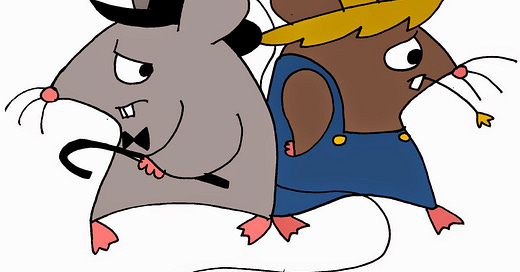The City Mouse and the Country Mouse
Americans remain connected to their roots, despite urban (and, suburban) migration.
In 1800, only 6% of the U.S. population lived in urban areas. One hundred years later, that percentage climbed to 40%, and by 1920, roughly half the population lived in cities and suburbs; the other half lived in rural settings. This urban (and, suburban) migration has continued, yielding the current 80% level, as of 2020; only 20% live in rural areas.
So, how does this explain the growth in popularity of country music, or of pickup trucks or of “Daisy Dukes?”
What’s that? You’re asking, “Why did you post a picture of Catherine Bach, who played Daisy Duke in the late-1970’s TV hit show The Dukes of Hazzard, posing in her ‘Daisy Dukes,’ rather than a picture of say, country music superstar Morgan Wallen, or a Ford F-150, to represent the embodiment of rural life?”
I’m glad you asked that question. Editorial decisions, including the placement of artwork in columns, are developed in consultation with Rule of Three’s Editorial Board, which is ever mindful of community standards and audience sentiment. The Board considered this specific artwork placement decision carefully, and settled on Ms. Bach’s picture, after rejecting Mr. Wallen’s picture, due to his abrupt exit from the Saturday Night Live (“SNL”) stage at the conclusion of last week’s show, which caused consternation among dedicated SNL viewers, and also determining that featuring a picture of a Ford F-150 might represent a slight towards other worthy competitors, including the Chevrolet Silverado, the GMC Sierra and the RAM 2500; no such concerns were identified regarding Ms. Bach’s picture.
An old Aesop’s Fable, entitled The Town Mouse & the Country Mouse, relates the story of a city-based cousin to a country-centered mouse, in which the “Town Mouse” visits his cousin in the country, and encourages him to travel with him to the city, to experience the luxuries and delights available there. There is indeed a veritable feast in which they indulge, but soon, a cat and servants and a dog roust them. The moral of the story is: Poverty with security is better than plenty in the midst of fear and uncertainty. Heavy, right?
There are many clear examples of this dichotomy which has long existed in the U.S., including: presidents (Jimmy Carter from Plains, Georgia and JFK, from Boston); Major League Baseball superstars (Babe Ruth, from Baltimore and Shoeless Joe Jackson, from Pickens County, South Carolina); and movie stars (Lady Gaga, from New York - New York again! and Taylor Swift, from West Reading, Pennsylvania).
Americans seem to want to remain connected to their rural heritage. As an example, we sometimes say, “He bought the farm,” when someone dies; we don’t say, “He bought a co-op on the Upper East Side.” Similarly, “Chickens come home to roost” is intended to convey that actions have consequences; if our mindset was largely influenced by our urban setting, we would substitute “pigeons” for chickens (although, honestly, I don’t know if pigeons actually come home to roost, so that idiom might not make any sense at all). And, finally, “You reap what you sow” has clear connectivity to old-time farming, but its etymology dates a bit further back, appearing in the Bible in Galatians 6:7; the Bible also hit the theme of “smiting” pretty hard - according to bible.knowing-jesus.com, there are 240 instances in which the word smite is reflected.
Certainly the gold standard for rural chest-thumping has to be the mark established in the early 1960’s. The report card is, of course, primetime television shows aired during those years. The vast lineup of television shows conducted in rural settings back then included: The Andy Griffith Show, The Beverly Hillbillies (technically set in Beverly Hills, but populated by a rural family), Petticoat Junction, Gomer Pyle, U.S.M.C., Mayberry R.F.D. and Green Acres. The Beverly Hillbillies even topped the TV ratings charts for two consecutive years: 1963 and 1964, a clear demonstration that there’s no accounting for taste.
Yes, certainly there have been urban-based TV shows, including: Dragnet (Los Angeles), Car 54, Where Are You? (New York), The Dick Van Dyke Show (New York), The Honeymooners (New York), The Office (Scranton), Seinfeld (New York), Friends (New York), The Mary Tyler Moore Show (Minneapolis), The King of Queens (New York), Everybody Loves Raymond (New York) and The Bob Newhart Show (Chicago), among many others. Having watched way too much television over the years, I can attest to several of those shows featuring barnyard animals on occasion: an episode of The Dick Van Dyke Show reflected Rob bringing a couple of ducks home; Jerry and Kramer on Seinfeld got themselves into a cock-fighting escapade; Joey and Chandler on Friends kept a duck and a chicken in their apartment (Ross had a monkey, but that’s hardly a barnyard animal); and, of course Dwight Schrute on The Office lived on a beet farm. Also, I know New York City is a very large city, but it certainly seems as if it has been overrepresented on television.
But, those shows caused us to nod along and commiserate with the characters in settings in which we could envision ourselves. The other, rural-based shows evoke an earlier, simpler time, a nostalgic look back at what we imagine our grandparents might have encountered, perhaps.
As painful as it might be (“My eyes, my eyes!”), I can envision Grampa sneaking a peek at the young lady who lived at the other end of the county, in her Daisy Dukes, perhaps while tooling about in his pickup truck, blasting country music.
You don't have to rely on rural free delivery (R.F.D.) to receive your weekly dose of Rule of Three - simply type your email address and click the button below to subscribe now to Rule of Three - it's free, man! 




